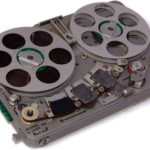In order to use this feature, you need register and become a member.
Already a member? Login Register hereNagra Reel to Reel Tape Recorders

1951 To Present
Company Description Submit New Info
Nagra produced reel to reel tape recorders from 1953 to 1980 which were manufactured in Switzerland. These tape recorders targeted the consumer market. The early models of Nagra tape recorders used tube electronics and later on they transitioned to solid-state tape recorders. The company produced both 2 and 4 track machines available in Multi & 220-240v voltages.
World War II
1939 -1945 – The family of Stefan Kudelski left Poland during the Second World War and eventually settled in Switzerland after living in Hungary and France.
Post-World War II
As he was unable to interest anyone in his CNC machine tool project, he turned his focus to designing a recorder suitable for broadcast use.
1951 – Stefan Kudelski founded Kudelski Company. Built a small, lightweight, portable tape recorder with a focus on sound quality and named it as “Nagra”, meaning “to record” in Polish.
1952 – First Nagra I was bought by a local radio station, followed by orders from both Radio Lausanne and Radio Geneva.
1953 – Established manufacturing operations at a house in Prilly (West of Lausanne) and production of the NAGRA II began.
NAGRA II – driven by a Grammophon spring from language laboratory equipment, and with excellent subjective and audio quality. The recorder is extremely sturdy; No advertising is needed, every day new reporters become acquainted with the machine and immediately try to buy one
1958 – Release of Nagra III – legendary radio, TV and cinema recorder. A solid-state machine employing an electric motor with closed loop servo speed control. A fully transistorized machine with all the modules enclosed in metal cases, powered by conventional “D” type batteries, and is equipped with a true peak meter called a “Modulometer”.
1959 – Italian radio network RAI (Radio Audizioni Italiane) ordered 100 machines to cover the Olympic Games in Rome.
1959 – French director Marcel Camus used a Nagra II to record part of the sound on the feature production of Black Orpheus. In result, Kudelski quickly set designing a version of the Nagra III that could utilize a pilot system for synchronous filming (referred to as the PILOTTON system).
1960s – Kudelski’s firm began making miniature recorders or “surveillance and security” work. First pocket-size machines was the SN “Serie Noire,” which was “originally ordered by President J F Kennedy for the American secret services”
1962 – Kudelski invented the “NEOPILOT” system, the standard synchronization system used to synchronize these separate elements.
1965 – Purchased a factory in Neuchâtel. A huge tract of land is purchased in Cheseaux-sur-Lausanne, which allowed for the construction of a dedicated factory.
1967 – Sale of the 10,000th Nagra III
1969 – Nagra IV recorder with more reliable silicon transistors and sported two mike inputs.
1970 – Nagra 4.2L recorder was released.
1971 – IV-S or the stereo version of the Nagra 4.2 was introduced, it offered two channels of recording in the same footprint as the mono recorder.
1971– New pilot system, called NagraSync FM, which records a FM modulated pilot signal at 13.5 kHz between the two audio tracks.
1971 – Launched of the unique SNN recorder, a miniature recording using 1/8” wide tape, but in a reel-to-reel configuration as opposed to a cassette which would mark the introduction of equipment destined for applications outside of the traditional film and broadcast arena.
1972 – Nagra IV-SJ, a two-channel instrumentation recorder aimed at scientific and industrial markets.
1974 – Introduction of Nagra IS, originally designed to be a single-speed mono recorder for reporters.
1976– Nagra E – a further simplification of the IS recorder.
1977 – Kudelski introduced the NAGRAFAX – unique portable weather facsimile machine aimed at the maritime market. This would mark Kudelski’s first departure from recording equipment.
1977 – Another instrumentation recorder, the Nagra TI with four channels of recording.
1981 – Nagra TA recorder with unique ability to chase timecode in forward and reverse, and was specifically aimed at the telecine post market.
1983 – Joint project-venture with Ampex (US) and launched AMPEX-NAGRA VPR-5, the world’s smallest, lightest professional portable C-format video recorder.
1984 – JBR security recorder was introduced to replace the ageing SNST technology with a smaller, undetectable covert recorder for the security industry.
1985 – Nagra T-AUDIO was also adapted to this new universal synchronization format. Became the most sophisticated transfer machine ever built and found in post-production facilities all over the world.
1992 – Nagra D, a unique (and proprietary) four-channel digital recorder aimed at the film and music recording market.
1997 – Introduced a line of high-end audiophile components, and later incorporating the VPA mono-block tube power amplifier and MPA 250-watt MOSFET power amplifier.
2002 – Nagra V, a hard drive recorder intended as replacement for the Nagra 4 series analog recorders.
2013 – Stefan Kudelski died on January 28th.







